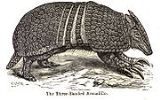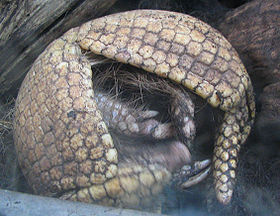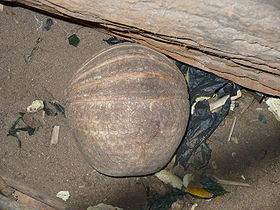
Southern Three-banded Armadillo
Encyclopedia
The Southern Three-banded Armadillo (Tolypeutes matacus), also called the La Plata Three-Banded Armadillo, is an armadillo
species from South America
. It is found in parts of northern Argentina
, southwestern Brazil
, Paraguay
and Bolivia
, at elevations from sea level to 770 m.
The Southern Three-banded Armadillo and the other member of the genus Tolypeutes, the Brazilian Three-banded Armadillo
, are the only species of armadillo capable of rolling into a complete ball to defend itself. The three characteristic bands that cover the back of the animal allow it enough flexibility to fit its tail and head together, allowing it to protect its underbelly, limbs, eyes, nose and ears from predators. The shell covering its body is armored and the outer layer is made out of keratin
, the same protein that builds human fingernails. They are typically a yellow or brownish color and are smaller than many other species of armadillos, ranging in size from about 9 to 13 inches when full grown. Unlike most armadillos, they are not fossorial
.
The Three-banded Armadillo has a long, sticky, straw-like pink tongue that allows it to gather up and eat many different species of insects, typically ants and termites. In captivity, armadillos also eat foods such as fruits and vegetables.
The species is threatened by habitat destruction from conversion of its native Dry Chaco
to farmland, and from hunting for food and the pet trade.
Armadillo
Armadillos are New World placental mammals, known for having a leathery armor shell. Dasypodidae is the only surviving family in the order Cingulata, part of the superorder Xenarthra along with the anteaters and sloths. The word armadillo is Spanish for "little armored one"...
species from South America
South America
South America is a continent situated in the Western Hemisphere, mostly in the Southern Hemisphere, with a relatively small portion in the Northern Hemisphere. The continent is also considered a subcontinent of the Americas. It is bordered on the west by the Pacific Ocean and on the north and east...
. It is found in parts of northern Argentina
Argentina
Argentina , officially the Argentine Republic , is the second largest country in South America by land area, after Brazil. It is constituted as a federation of 23 provinces and an autonomous city, Buenos Aires...
, southwestern Brazil
Brazil
Brazil , officially the Federative Republic of Brazil , is the largest country in South America. It is the world's fifth largest country, both by geographical area and by population with over 192 million people...
, Paraguay
Paraguay
Paraguay , officially the Republic of Paraguay , is a landlocked country in South America. It is bordered by Argentina to the south and southwest, Brazil to the east and northeast, and Bolivia to the northwest. Paraguay lies on both banks of the Paraguay River, which runs through the center of the...
and Bolivia
Bolivia
Bolivia officially known as Plurinational State of Bolivia , is a landlocked country in central South America. It is the poorest country in South America...
, at elevations from sea level to 770 m.
The Southern Three-banded Armadillo and the other member of the genus Tolypeutes, the Brazilian Three-banded Armadillo
Brazilian Three-banded Armadillo
The Brazilian Three-banded Armadillo is an armadillo species endemic to Brazil. It is one of only two species of armadillo that can roll into a ball...
, are the only species of armadillo capable of rolling into a complete ball to defend itself. The three characteristic bands that cover the back of the animal allow it enough flexibility to fit its tail and head together, allowing it to protect its underbelly, limbs, eyes, nose and ears from predators. The shell covering its body is armored and the outer layer is made out of keratin
Keratin
Keratin refers to a family of fibrous structural proteins. Keratin is the key of structural material making up the outer layer of human skin. It is also the key structural component of hair and nails...
, the same protein that builds human fingernails. They are typically a yellow or brownish color and are smaller than many other species of armadillos, ranging in size from about 9 to 13 inches when full grown. Unlike most armadillos, they are not fossorial
Fossorial
A fossorial organism is one that is adapted to digging and life underground such as the badger, the naked mole rat, and the mole salamanders Ambystomatidae...
.
The Three-banded Armadillo has a long, sticky, straw-like pink tongue that allows it to gather up and eat many different species of insects, typically ants and termites. In captivity, armadillos also eat foods such as fruits and vegetables.
The species is threatened by habitat destruction from conversion of its native Dry Chaco
Gran Chaco
The Gran Chaco is a sparsely populated, hot and semi-arid lowland region of the Río de la Plata basin, divided among eastern Bolivia, Paraguay, northern Argentina and a portion of the Brazilian states of Mato Grosso and Mato Grosso do Sul, where it is connected with the Pantanal region...
to farmland, and from hunting for food and the pet trade.
Gallery
 |
 |

